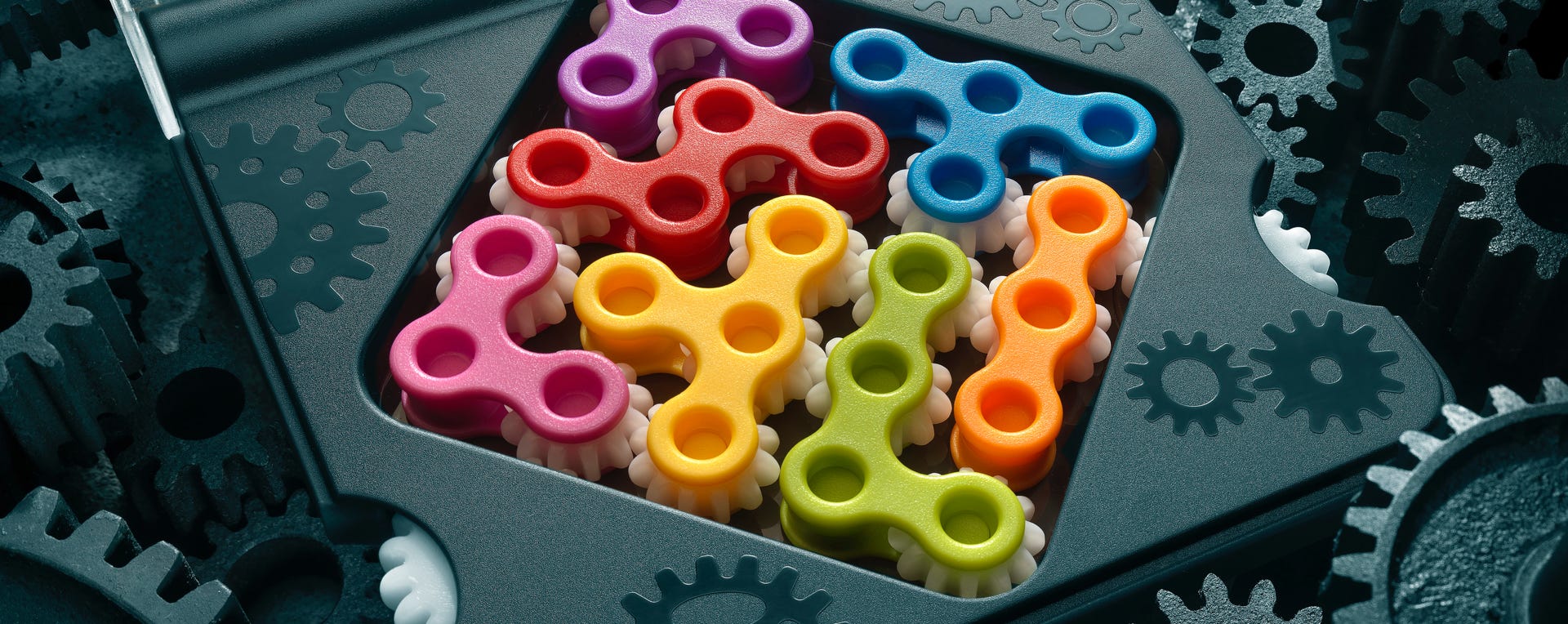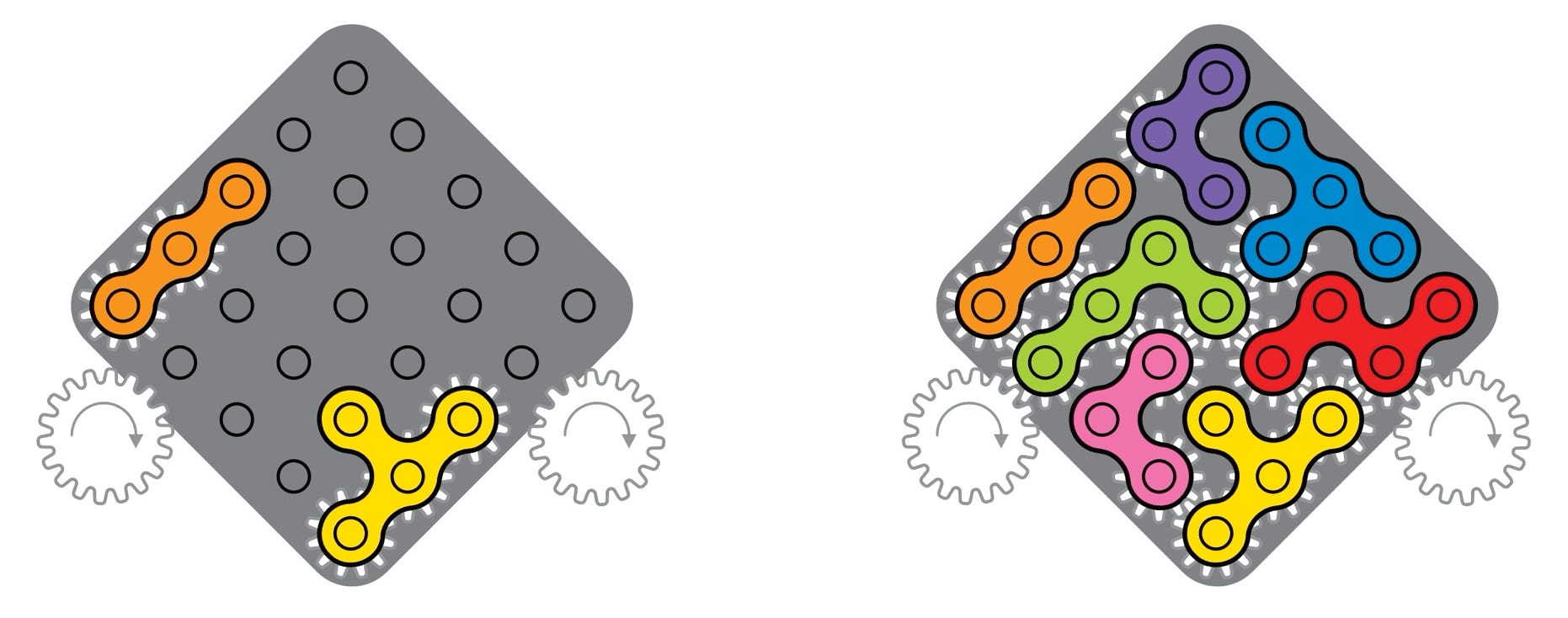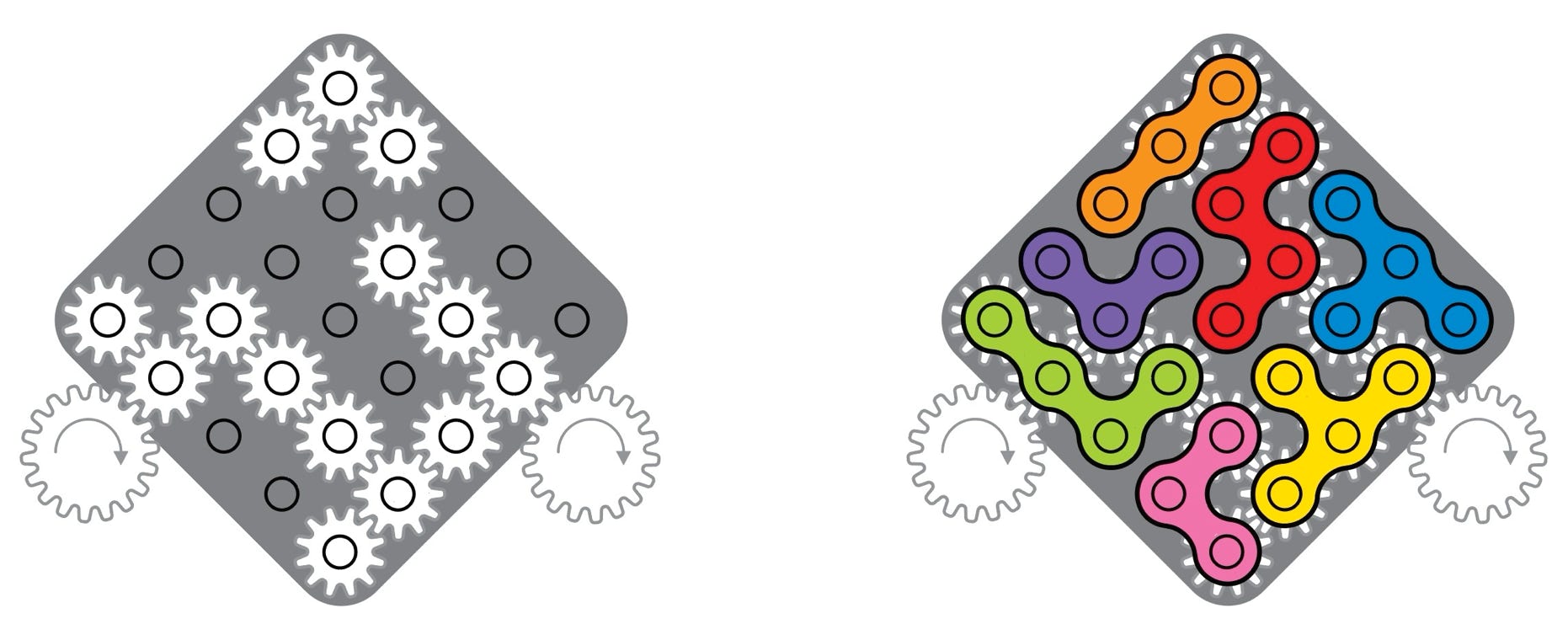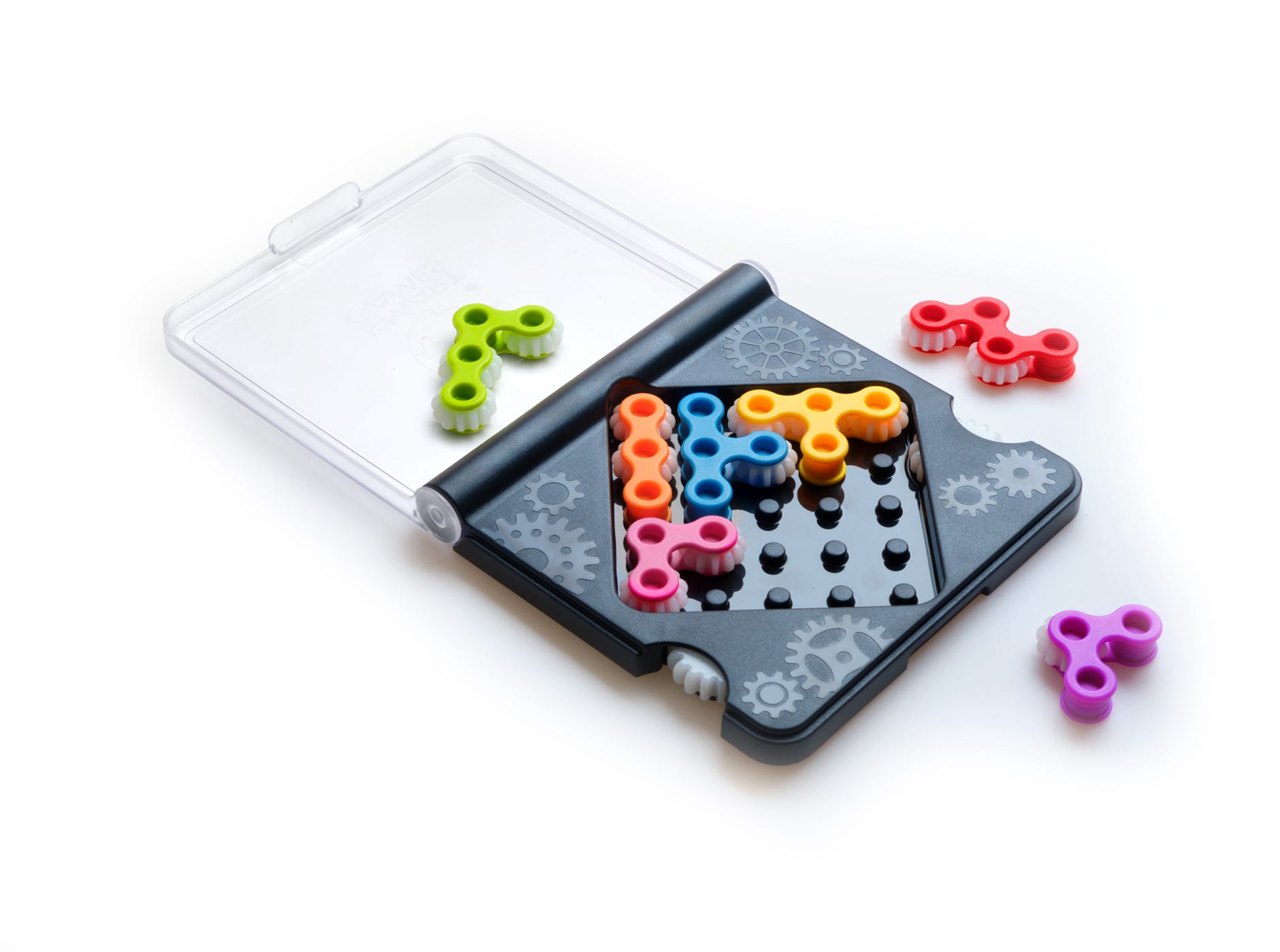
IQ-Gears
The product development of IQ-Gears (for SmartGames)
Raf Peeters, January 2024

IQ-Gears is a new IQ+ game developed for SmartGames in 2023. As the name suggests, it features gears, setting it apart from the more than 15 other IQ-puzzles I've designed since 2010. Yet, it's not entirely different because, like other puzzles in this sub-brand, it primarily is a packing problem. But at the same time, it’s also a connection game because the objective is to fill the grid AND to make a connection between the large gears on the left and right of the game board.
STIMULATE YOUR COG-NITIVE SKILLS
For many years, I wanted to create a puzzle with gears. I had a vague idea of how it should work, but the prospect of a time-consuming and potentially complicated project held me back. I was also concerned it might become too difficult and therefore a niche product with limited appeal for the average consumer. It was a perfect excuse to never start with the design process. The reason why I feared it would be complex is that I wanted to use different types of gears in different sizes. The challenge with that is that you need to find a way to avoid gears getting stuck. Because that would frustrate players, at least when it’s not clear why they block in the first place: is it because they didn’t find the right solution or because the mechanism was poorly designed and causes everything to jam?
The solution for all these problems was doing what I do best (IMHO): keep it simple. IQ-Gears uses only one size and type of gear, integrated into simple-looking puzzle pieces that fill an orthogonal grid. This design choice ensures gears can never block each other, and they will always fit and rotate. The only gears that are bigger are the ones on the left and right. These are part of the game board and can’t be placed elsewhere. Rotating the grid 45° created enough space for these big gears on the edge of the game board. The object of the game is to make a connection between these big gears using the small gears within the puzzle pieces. It’s not that easy because only 14 of 25 positions inside the puzzle pieces have gears. The 11 positions inside the puzzle pieces without gears will, of course, never make connections to adjacent pieces. All puzzle pieces are double-sided, although for many shapes it doesn’t make a difference because they are symmetrical. To make a connection, you need at least half of the small gears to be in the right position, but often more. This means that in most challenges there also will be a few gears that won’t rotate, which is fine. Theoretically, gears are not really needed to make a game concept like this work. I could have made pieces with a print and told players they just need to check if there is a connection between left and right. However, the gears offer constant tactile and visual feedback on your progress while you play, making the gameplay more engaging and rewarding. When we were developing this game, we were a bit afraid that the mechanics wouldn’t work smoothly. This was very hard to test with prototypes because the prototyping material is much rougher than the real product. If we made the gears a little bit too big, the whole mechanism would block or it becomes very difficult to place puzzle pieces on the game board. But if the gears were too small, the puzzle pieces would flip out of the grid unintentionally when you tried to rotate the gears. Therefore, we made the teeth of the gears a little rounded (in cross-section). This way, it’s easier to add new puzzle pieces to the game board. The round edge guides them to the right place and will also rotate the gears in a fitting orientation. Another solution was to use polyamide instead of ABS for the white gears. This material feels a bit more greasy. And of course, we made a lot of prototypes to get the tolerances right. But in the end, we are very happy with the result because it works perfectly. The only thing that might bother some players is how to remove a puzzle piece when the game board is filled? There is a very easy trick for it. Just close the lid, hold the complete game upside down, and open the game again. This way, all puzzle pieces end up in the lid, and you can start your next challenge with an empty game board. BTW, this also works for all other IQ-Games.
What I specifically like about this game is the fact that some levels are different from others. While most SmartGames vary primarily in challenge difficulty, IQ-Gears offers distinct variations in gameplay between levels. The STARTER level displays all pieces, often without revealing their color or the position of the little gears. Other levels reveal the position of specific puzzle pieces, showing color and gears. But the MASTER level focuses solely on the position of the little gears. Making a connection is not a problem here because this is already given in the challenge. But identifying where each puzzle piece needs to go to have gears in those positions requires a completely new strategy and a different way of thinking.
While this game seems complex at first sight, it’s easier than you think. Therefore, IQ-Gears has only 8 instead of the usual 24 challenges in the WIZARD level. But to compensate for this, you get many more challenges in all other levels, which is maybe more interesting for most people. Personally, I always prefer the challenges in the EXPERT and the MASTER level. The challenges in a WIZARD level are the ones that nobody could solve in 10 minutes or less. That might sound great for the few players in the world that have that much patience and perseverance. But 25 years of play testing learned me that most people find that rather frustrating and prefer challenges that are still doable within a reasonable timeframe. To ensure customers don't overlook the fact that this puzzle game revolves around gears, we added larger gears on the surface of the game board. Although these are non-functional, they serve the important purpose of communicating the product's theme, especially for those who may not natively speak English and are not familiar with the word “gear” in the name of the product. IQ-Gears will be available Spring 2024.

Example of a JUNIOR challenge (left) and solution (right) of IQ-Gears

Example of a MASTER challenge (left) and solution (right) of IQ-Gears that only shows the position of the gears

GAME RULES IQ GEARS
1) Remove all of the puzzle pieces from the game board. Choose a challenge. Place the indicated puzzle piece(s) on the game board as shown in the challenge:
A) Most challenges show complete puzzle pieces. NOTE: the correct position of the gears in these puzzle pieces is very important. Sometimes a puzzle piece fits on the same place on the game board with its gears on a different position. The gears must be in the correct position to solve the challenge.
B) STARTER level challenges show the shape of all pieces, but not the position of the little gears. Sometimes the color of a piece is also not revealed (these pieces are shown in grey). Please note that several pieces have an identical shape!
C) MASTER level challenges only show the position of all of the gears. You have to deduce the position of the full puzzle pieces.
2) Place all of the other puzzle pieces on the game board. You are not allowed to change the position of pieces indicated in the challenge! To solve the challenge all pieces should fit AND create a connection between the big gears (wheels) on the right and left of the game board. You can easily check this by rotating one of the bigger gears and see if the other big gear also rotates. You need a minimum 7 smaller gears to make a connection (often more). It is not necessary that all small gears rotate, only the big gears (wheels) on the sides of the game board need to rotate.
3) There is only 1 solution, found at the end of the challenge booklet.
Website ©2024 Raf Peeters
Products and images: © Smart